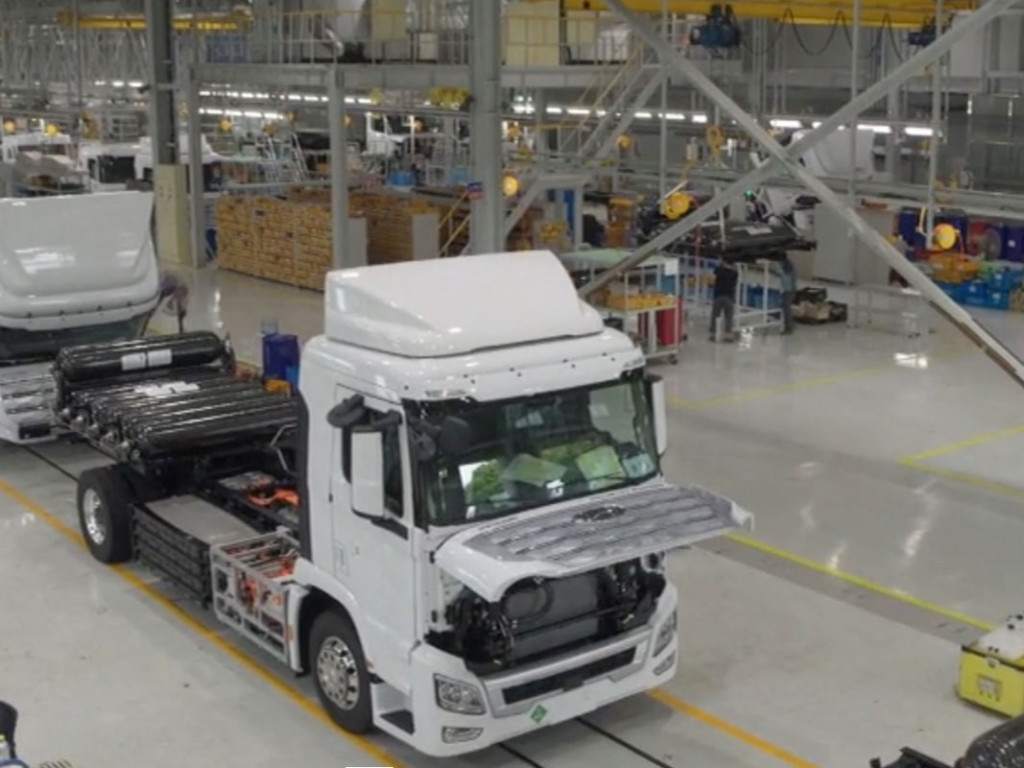Last month, two vehicle manufacturing giants threw down markers for hydrogen-propelled, heavy-duty trucks. These are an alternative type of zero-emission vehicle that uses hydrogen gas as a fuel source, converted into electricity through fuel cells.
First, Hyundai delivered an initial seven hydrogen-powered trucks to customers in Switzerland. Then, Toyota Motor Co. announced a joint venture with truck maker Hino Motors to develop fuel-cell based electric trucks specifically for the North American market. A demonstration model is expected next year, with customer trials in Japan announced for 2022.
Fuel cells provide a catalyst that combine hydrogen gas and oxygen to generate electricity, which propels the motor. Water is the only byproduct.
This technology offers two huge advantages over vehicles dependent on lithium ion batteries: range and refuel time. Today, a truck can travel 500 miles on a tank of hydrogen. According to Hyundai, refuel takes eight to 20 minutes. By comparison, a battery-sourced electric truck can travel no more than 250 miles, and takes more than three hours to recharge. And the batteries are heavy, reducing payload.

What’s more, the cost of a fuel-cell-equipped Class 8 tractor is about $60,000 less than an ion lithium battery-based semi, according to figures culled by the Brussels-based NGO, Transport & Environment, although these are rough estimates.
By 2030, Transport & Environment estimates fuel-cell enabled trucks will easily travel 750 miles on a tank with refueling only 10 to 20 minutes.
But there’s one enormous drawback: Fuel costs, which are extremely high. In terms of propulsion, a kilogram of hydrogen is about equivalent to a gallon of diesel. But currently, the median price of hydrogen in the US is about $11.50/kg, according to a recent study by the International Council on Clean Transportation, with a minimum price of $8.80/kg. In Europe, it runs even higher, with a median price at about $16/kg, but a minimum price of $7.49/kg.
Using hydrogen as a fuel source is today about twice as efficient as diesel. At an average cost of diesel these days running about $2.37, that means hydrogen is at best almost four times as expensive as a fuel source and twice as expensive in terms of miles traveled.
That assumes hydrogen fuel is available where needed, which is by no means a safe assumption. According to the US Department of Energy and the California Air Resources Board, there are now 43 public hydrogen fueling stations nationwide, of which 42 are located in California, with Connecticut having one as well. (Plug-in battery recharge stations, by contrast, totaled 78,300 last year, according to the Department of Energy.) New hydrogen stations aren’t cheap to build, either, with costs of at least $2 million each, according to the California Fuel Cell Partnership.
The current hydrogen refueling stations are supporting Hyundai, Toyota and Honda cars, with BMW set to launch its own hydrogen-fueled car in 2022. For obvious reasons, these vehicles are available only in California.
Then, there’s the issue of the hydrogen fuel itself. In the US, almost all hydrogen now is produced from natural gas, which means it indirectly is dependent on fossil fuel and contributes to carbon dioxide emissions. The hope is that long-term, renewables such as solar and wind will provide the energy needed to create the hydrogen gas through a process called electrolysis and that fuel stock costs will drop dramatically.
Hydrogen-fueled vehicles aren’t new. GM had introduced its fuel-cell enabled Electrovan in 1966. Twenty years later, Toyota and Mazda launched cars that ran on hydrogen; Daimler introduced a hydrogen-fueled bus the same year.
But for obvious reasons of both infrastructure and cost, hydrogen vehicles lagged. That was especially true of heavy duty trucks, which by their very nature, need an established chain of filling stations.
A five-year-old startup called Nikola Corp. has been blowing the loudest horn for fuel cell trucks. Phoenix-based Nikola boasted an ambitious, multi-billion-dollar plan to develop and construct 700 refueling stations across North America that would support its semis, which have yet to be produced.
After it went public in June, Nikola was worth more than $28 billion. It announced a partnership with GM in early September, under which GM would provide the fuel cell technology as well as manufacture Nikola’s light trucks.
Nikola’s fortunes plummeted soon after. Its high-powered founder, Trevor Milton, was forced to resign as executive chairman in late September. This followed a damning report by a short seller, which alleged fraud and deception. Nikola is now the subject of multiple US government department investigations. Its stock price plunged and its tie-up with GM remains iffy.
Meanwhile, Hyundai, far more quietly, continues to deliver hydrogen-powered trucks to customers in Switzerland. A total of 50 are scheduled this year and the South Korean company promised it would manufacture a total of 1,600 such trucks by 2025.
_-_127500_-_2cc4df0572d9388b880134e5c96a0a67f8647ac9_lqip.png)

